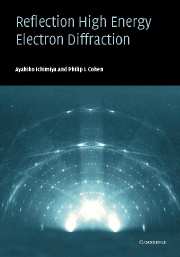Book contents
- Frontmatter
- Contents
- Preface
- 1 Introduction
- 2 Historical survey
- 3 Instrumentation
- 4 Wave properties of electrons
- 5 The diffraction conditions
- 6 Geometrical features of the pattern
- 7 Kikuchi and resonance patterns
- 8 Real diffraction patterns
- 9 Electron scattering by atoms
- 10 Kinematic electron diffraction
- 11 Fourier components of the crystal potential
- 12 Dynamical theory – transfer matrix method
- 13 Dynamical theory – embedded R-matrix method
- 14 Dynamical theory – integral method
- 15 Structural analysis of crystal surfaces
- 16 Inelastic scattering in a crystal
- 17 Weakly disordered surfaces
- 18 Strongly disordered surfaces
- 19 RHEED intensity oscillations
- Appendix A: Fourier representations
- Appendix B: Green's functions
- Appendix C: Kirchhoff's diffraction theory
- Appendix D: A simple eigenvalue problem
- Appendix E: Waller and Hartree equation
- Appendix F: Optimization of dynamical calculation
- Appendix G: Scattering factor
- References
- Index
1 - Introduction
Published online by Cambridge University Press: 06 July 2010
- Frontmatter
- Contents
- Preface
- 1 Introduction
- 2 Historical survey
- 3 Instrumentation
- 4 Wave properties of electrons
- 5 The diffraction conditions
- 6 Geometrical features of the pattern
- 7 Kikuchi and resonance patterns
- 8 Real diffraction patterns
- 9 Electron scattering by atoms
- 10 Kinematic electron diffraction
- 11 Fourier components of the crystal potential
- 12 Dynamical theory – transfer matrix method
- 13 Dynamical theory – embedded R-matrix method
- 14 Dynamical theory – integral method
- 15 Structural analysis of crystal surfaces
- 16 Inelastic scattering in a crystal
- 17 Weakly disordered surfaces
- 18 Strongly disordered surfaces
- 19 RHEED intensity oscillations
- Appendix A: Fourier representations
- Appendix B: Green's functions
- Appendix C: Kirchhoff's diffraction theory
- Appendix D: A simple eigenvalue problem
- Appendix E: Waller and Hartree equation
- Appendix F: Optimization of dynamical calculation
- Appendix G: Scattering factor
- References
- Index
Summary
Reflection high-energy electron diffraction (RHEED or R-HEED) is a technique for surface structural analysis that is remarkably simple to implement, requiring at the minimum only an electron gun, a phosphor screen, and a clean surface. Its interpretation, however, is complicated by an unusually asymmetric scattering geometry and by the necessity of accounting for multiple scattering processes. First performed by Nishikawa and Kikuchi (1928a, b) at nearly the same time as the discovery of electron diffraction by Davison and Germer (1927a, b), RHEED has assumed modern importance because of its compatibility with the methods of vapor deposition used for the epitaxial growth of thin films. We take RHEED to encompass the energy range from about 8 to 20 keV, though it can be employed at electron energies as high as 50 to 100 keV.
Because of its small penetration depth, owing to the interaction between incident electrons and atoms, RHEED is primarily sensitive to the atomic structure of the first few planes of a crystal lattice. Diffraction from a structure periodic in only two dimensions therefore underlies the observed pattern, and the positions of the elastically scattered beams can be computed from single-scattering expressions. Nonetheless, because the elastic scattering is comparable to the inelastic scattering, multiple scattering processes are also crucial, and these must be included to obtain the correct intensity. The RHEED geometry – an incident beam directed at a low angle to the surface – has a very strong effect on both the diffraction and its interpretation.
- Type
- Chapter
- Information
- Reflection High-Energy Electron Diffraction , pp. 1 - 2Publisher: Cambridge University PressPrint publication year: 2004



